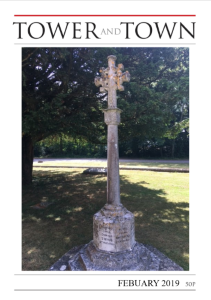

Tower and Town, February 2019 (view the full edition) (view the full edition)The Old Oaks Of Savernake ForestNow is the season of the year to admire the ancient oaks that we are so fortunate to have on our doorstep in Savernake Forest - not the Spring, not the Summer, despite the attraction of the trees when they are in full leaf. In the Winter, the leaves have fallen and the undergrowth has died back and through the more recent plantations of oak and beech you can see the thick, knobbly trunks of many old oaks with their heavy writhing branches, many of them collapsing under their own weight. They are a stunning sight. No wonder they are given names such as King of Limbs and Spider Oak. These oaks are wonderfully aged. Big Bellied Oak, such a well-known feature by the side of the A346; Cathedral Oak, on the northern boundary quite near the picnic site; and the sad remains of Duke's Vaunt, almost hidden beyond the firs at the far end of the forest, each have girths of approximately 10 metres, which gives them an age of roughly 1,000 years. Two of these are hollowed with age: under Duke's Vaunt, according to tradition, Henry VIII courted Jane Seymour, and later there was enough room to shelter a choir of twenty boys. These trees are among the oldest oaks in the country; one of them may be the oldest. Twenty-four of the ancient oaks of Savernake are named and nearly all have boards situated below to identify them. Peter Noble's excellent map, available for a small charge in St Peter's Church (the money goes to charity), will guide you to these trees - and on the way you will see scores of others that you will guess from the girth of their trunks and twisting of their boughs are old enough to be candidates for appropriate names. Hug an oak! One span of your arms equals roughly 100 years of growth! Oaks are a major element of our national history: it took 1,400 to provide the timber for Salisbury Cathedral and 3,000 or more to construct Nelson's HMS Victory. The demand for timber for shipbuilding in the 18th century was so severe that during his lifetime one worried landowner trod 900,000 acorns into the soil as he walked around his lands. No wonder that Hearts of Oak is the march of the Royal Navy and that the oak leaf is the symbol of the National Trust. John Osborne |